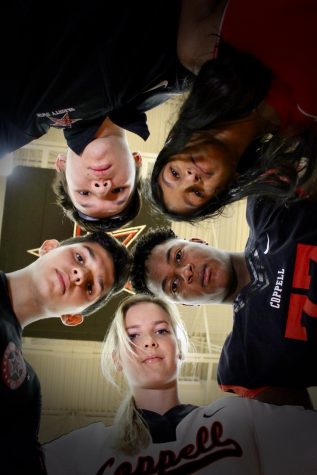Coloring in the lines
Analyzing racial, ethnic, regional trends in sports
Sports such as softball, cross country, soccer, swimming and football all have races that are stereotyped as participants. These racial patterns can be seen both on a professional and high school level.
January 2, 2020
Throughout the world, about 200 sports are internationally recognized. In total, there are an estimated 800 sports throughout the world, including regional and specialized sports. Just as those smaller-scale sports are associated with a specific region, ethnic group, race or nationality, larger sports take on similar patterns – with certain locations or groups producing more successful athletes. Upon the large canvas of stereotypical athletes, various sports are painted with diverse colors.
Peeling back the layers
Just as the final color of paint is the product of the many layers beneath, certain races and nationalities are more prone to participate in some sports than others due to a multitude of reasons, many of which build upon each other.
The origins of some of the most popular sports in America, football, basketball and baseball, were all unsurprisingly located within the country itself.
Football, which developed into a sport during the late 19th century, is actually based off of the English sport rugby, which developed from soccer. The uniquely American take became popular throughout the country and is now the leading spectator sport of the nation, as it has been since the late 1960s.
It has remained uniquely American because it has not had a chance to spread as other sports have.
America, unlike Britain and other major European colonizers, was a global influence for significantly less time and in a more concentrated area. At the peak of American imperialism from the mid 1800s to the mid to late 1900s, the most popular sport in the country was baseball (which is based off the popular British sport cricket). Baseball spread to areas such as Cuba and Japan, where it then spread further to places such as Puerto Rico and the Dominican Republic. In areas where America influenced the culture through colonization and military occupation, baseball is popular, whereas former British colonies such as India have a strong love for cricket. It is even reflected in MLB racial demographics, which show Latinos as the second-largest population behind white people.
However, this pattern of diffusion left football and basketball mainly in America.
On the professional level, the NFL and NBA’s players are mostly black people, with both statistics more than 70%. While both organizations originally began as white-dominated sports leagues, they eventually turned non-segregated with the breaking of the color barrier by Kenny Washington for football in 1946 and Earl Lloyd, Chuck Cooper and Nathaniel Clifton for basketball in 1950.

While football originated as a white-dominated sport, the NFL currently consists majority of black players. According to Tides 2017 NFL Report, the diversity of the organization has increased over the years.
The reasons why these sports have such a strong black presence are debated and likely a combination of multiple factors, such as economics and historical segregation from other sports. Some even theorize there may be biological differences leading to higher success for black people in certain sports or positions within a sport, but those are unconfirmed.
Basketball is a relatively inexpensive sport with the only necessary equipment being a ball and a hoop. It was created by James Naismith in the early 1890s as a way to impart masculine values and good discipline on young men through the Young Men’s Christian Association (YMCA) system. However, due to the strict segregation of the time, it did not catch on with the black population. Many years later, a black man named Edwin Bancroft Henderson attended Harvard University’s Summer School for Physical Training, where he was introduced to the sport. Due to the strict race laws still in place, Henderson established the first black basketball league in the nation. As time progressed, black-only teams such as the Harlem Globetrotters took root and became popular throughout the nation.
Now, basketball is one of the stereotypical “black” sports.
Another angle to examine is the possibility for a collegiate experience granted through athletic scholarships. While on paper, the numbers are rather small with 3.4% of players moving to collegiate men’s basketball and 6.8% of players moving to collegiate football, the hope is enough for some players. As economically, black people are more likely to live in poverty and lower income families, athletic scholarships offer them opportunities to make it. A lack of education opportunities or, at least, the same education opportunities as their peers (some who can afford tutoring or private education) can mean a lesser chance of receiving an academic scholarship.
For those who cannot afford higher education on their own, an athletic scholarship is their strongest opportunity.
Beyond economic reasons, the power of the media is also a strong factor in the sports student athletes play in America. According to Coppell tennis coach Rich Foster, the media influences the way American athletes choose their sports.
“We are a sports-oriented society, we have so many sports to choose from and kids at a very young age, they watch media,” Foster said. “The U.S. Open is big, it’s on TV, but football, during football season, is on TV on a daily basis. Baseball is on TV on a daily basis. Our kids tend to migrate towards their heroes. Most American athletic kids, kids that are genetically predisposed to be athletes, they watch TV and they want to be what they see all the time. In advertisements, you’re gonna see Dak Prescott, you’re gonna see James Harden, you’re gonna see all these big-name basketball and football players, and that’s what our kids want to be.”
In regards to tennis, which is a global sport, the resulting demographic is very diverse – far beyond what is seen from either football or basketball (though basketball is gaining more international popularity each day).

While basketball originated as a white-dominated sport, the NBA currently consists majority of black players. According to Tides 2017 NBA Report, the diversity of the organization has increased over the years.
“The only big sport tennis has to compete with in other countries, in my opinion, is soccer,” Foster said. “Soccer is huge, it is the one international sport that is just everywhere and everybody plays it. My theory is that you take a great tennis player like Roger Federer and Rafael Nadal – in [their home] countries, basically, they had soccer and tennis. You get more true athletes going for tennis, your big, strong athletic guys going for tennis. In America, there are so many different sports vying for those athletes’ attention. If Roger Federer lived in the United States as a young boy, he might have been a basketball player or a football player. Because he was living somewhere else and growing up in a society that was not focused on 30 different sports, he chose a sport that not as many athletes in America would choose.”
Around the world, certain centers are more successful in producing high caliber tennis players – for men’s tennis, it is mainly white men from Europe and for women’s tennis, it is mainly African Americans.
“If you look at men’s tennis, we have not had a dominant American-born player in many, many years,” Foster said. “We’ve maybe had some rise up and fade away, like Andy Roddick, but you would have to go back to Pete Sampras, [who] was the last great American-born tennis player. When I was a kid, Australia was producing all the great tennis players. Now it’s Spain, Sweden, the European countries…On the ladies’ side, I don’t want to say America dominates but [with] the Williams sisters and the new young lady, Coco [Gauff], others from America – we are still very dominant.”
Another sport in which America shows a strong presence is swimming.
With powerful names such as Michael Phelps and Katie Ledecky, America has set numerous world records and won more Olympic medals than any other nation by a large margin. There has been a new name in the competitive swim world in recent years: American freestyle specialist Simone Manuel.
At the Rio 2016 Olympics, Manuel became the first African American woman to win an individual Olympic gold in swimming when she won the 100-meter freestyle. Manuel is a minority in the pool, standing beside American freestyle specialist Cullen Jones as two of the scant black names associated with swimming.
The relative lack of black swimmers can be explained by some startling statistics; according to a report by USA Swimming in 2017, 64% of black American children have “no or low swimming ability.”
This can be attributed to historical segregation within America, as a 2010 BBC study analyzes. During times of slavery, black slaves were not permitted to learn to swim. After emancipation and during the time of strict segregation, public pools were mainly kept for white people. With the end of segregation, many white people abandoned public pools for private clubs and said pools became low priority in the public eye. Pools built in majority black areas were not large enough to swim in, often being only three-and-a-half feet deep. The BBC study continues, pointing to a passed on mindset from parents to their children in regards to swimming. As many black adults cannot swim, that fear of drowning prevents them from teaching their children to swim, which overall affects the pool of black swimmers that feeds into the Olympics and other major swim tournaments.
While the nation continues to rack up victories in the pool, the largest racial minority in the country remains disproportionately represented.
Because [Roger Federer] was living somewhere else and growing up in a society that was not focused on 30 different sports, he chose a sport that not as many athletes in America would choose.
— Coppell tennis coach Rich Foster
Outside of America, the most popular sport in the world is soccer. Referred to as “football” by countries other than the United States, soccer has spread rapidly throughout the world in popularity.
Foot sports similar to soccer have been played throughout history, including military exercises from the Han dynasty in China to the Roman version of the game which spread to Britain and eventually evolved into the modern day sport. Notably popular in England, the sport was spread through colonization efforts, as well as by British traders and sailors.
One of the main reasons the sport gained so much popularity is due to its simplicity. Requiring only a ball and anything that could resemble a goal, it is significantly less expensive than sports such as football, which requires specialized equipment and many separate components. As an activity that can be played regardless of socioeconomic status, soccer spread throughout even impoverished countries and has grown to the single most popular sport in the world.
In 2018, the World Cup was viewed by 3.57 billion people around the globe. As of 2008, 226 countries have soccer as their No. 1 sport; of the remaining 35, 21 countries place soccer as second. While stereotypes of Latino and European fans are valid in that both Latin America and Europe are incredibly strong fan bases for soccer, the truth is that soccer paints most of the world as fans. Each continent, with the exception of Antarctica, has a fan base of soccer. With four billion fans worldwide, soccer is a true transglobal phonomenon – the product of globalization, cultural diffusion and the rapid spread of pop culture.
The high school landscape
Coppell High School, boasting an athletics department of 13 sports on its official website plus additional non-UIL sanctioned sports, is divided in its following of stereotypical patterns. While some sports, such as football and baseball, resemble the professional level, others, such as tennis, more closely align with the racial demographics of the school itself.
“Tennis in itself is very much an international sport,” Foster said. “You take football, it’s a very American sport. We’re starting to see some international players enter the football game, but it’s predominantly black and white Americans who are involved. Soccer is very European, you see a lot of European players. Golf and tennis tend to be very international. Texas reflects that a little bit, but Coppell even more so. Coppell is a true melting pot. We have people living in this area from all over the world. It’s true on our tennis team, especially in recent years.”
The tennis team, with a mixed population of Asians, Latinos and white people, was not always as multiethnic as it is now. As Coppell seemed to diversify over the years, the team followed suit.
“When I first came to Coppell [High School] to work as an assistant tennis coach, I believe it was 1995, our tennis team was probably 90% white,” Foster said. “Through the years, our Asian population has grown exponentially. On our tennis team, our Asian population is a lot higher than our white population. It’s a sport that is loved by people all over the world.”
The Asian population of CHS, as reported by the 2017-18 Texas Academic Performance Report (TAPR), surpassed the white population, the former being 40.8% and the latter being 36%, both excluding people identifying as two or more races, which is similar to Foster’s observed racial layout of the varsity tennis team. Compared to the 2018 reportings of the NCAA of male and female student-athletes, both divisions of tennis are majority white. However, with 53% and 56% respectively, that majority is declining compared to the 2008 report, which shows a 72% and 75% white majority. Such diversity in the collegiate levels trickle into the professional level and serves as a source of role models for high school athletes, in addition to the professional athletes from other countries.
According to Foster, seeing one’s own race succeeding within a sport inspires one to take on the sport and work hard at it.
“With anything, you watch a young kid who aspires to be a football player, they’re going to look at their idols of that sport and try to be like their idols,” Foster said. “For our international students, they can look at a sport like tennis and see someone from their homeland doing well and they aspire to be like that person. It inspires them to work hard and to be like somebody that they admire.”
According to World Atlas in 2018, tennis is the fourth most popular sport with one billion fans around the globe. The international reach of the sport is a major factor in how the sport is taken on by multiple races and ethnicities at CHS.

Coppell senior goalkeeper Carlos Arconada, junior swimmer Ivan Lau and seniors tennis player Aishwarya Kannan, football player Nick Quilens and softball player Olivia Reed stand in a huddle in the CHS Arena. Most sports are associated with a particular race that excels in them.
Even with sports such as football, in which the Coppell team consists of a majority black and white player population, the trend is shifting towards more diversity. Coppell senior offensive lineman Aayush Dalal is one of two Indians on the varsity football team and notes the shift in the racial demographics.
“There were not a lot of Indians back when I was first starting to play,” Dalal said. “As the years kept on going, especially this year, in the younger groups, there are so many Indian kids. I feel like there’s been something that’s happened, a certain change that has happened in the past few years.”
Dalal, who began playing in the eighth grade at Coppell Middle School West, originally faced opposition from his parents regarding playing the sport.
“They heard of football and they were aware of what happens in football, meaning you get hit a lot,” Dalal said. “They were kind of scared at first that I was just going to be in such a bad condition, that I wouldn’t be able to move around a lot or something like that. It’s something that scared them, but they eventually got over it.”
Many of the main popular sports in India are limited or non-contact sports such as tennis, badminton and cricket. Indian culture has a limited influence from contact sports. Some of those sports include wrestling, soccer, field hockey and kabaddi (which is a team contact sport with its highest popularity in South Asia). Despite being a former British colony, India does not have that strong of a rugby presence (though it is estimated to be growing), nor many other contact sports such as football, lacrosse or ice hockey.
The worries about players’ safety resembles those shared by many parents. This concern over safety is also influencing white and black participation, and the general popularity of the sport, as concerns of chronic traumatic encephalopathy (CTE) rise. Overall, the participation in football has declined nationwide for a multitude of theorized reasons, including said health concerns, early sports specialization and a decreasing school-aged child population, according to Forbes’s Bob Cook.
However, in Coppell, there is still a large participation in the sport, with a varsity team, two junior varsity teams and three freshmen teams.
While there are only two Indians on the varsity team (the same number as the total number of Indian players in the NFL throughout its entire history), the Indian demographic is represented in other sports.
“When we have offseason during the spring season, I see a ton of Indian kids in different sports like soccer, tennis, track,” Dalal said. “You could say baseball doesn’t have a lot of Indians too, but other than that, not many other sports have [very few Indians].”
Coppell is growing in diversity, both in school population and sports participation. As more ethnic percentages grow, the trend in the athletics sector is expected to follow. In years to come, the high school’s athletic canvas might become less and less monochrome.
Follow Sally (@sparampottil) and @SidekickSports on Twitter.














